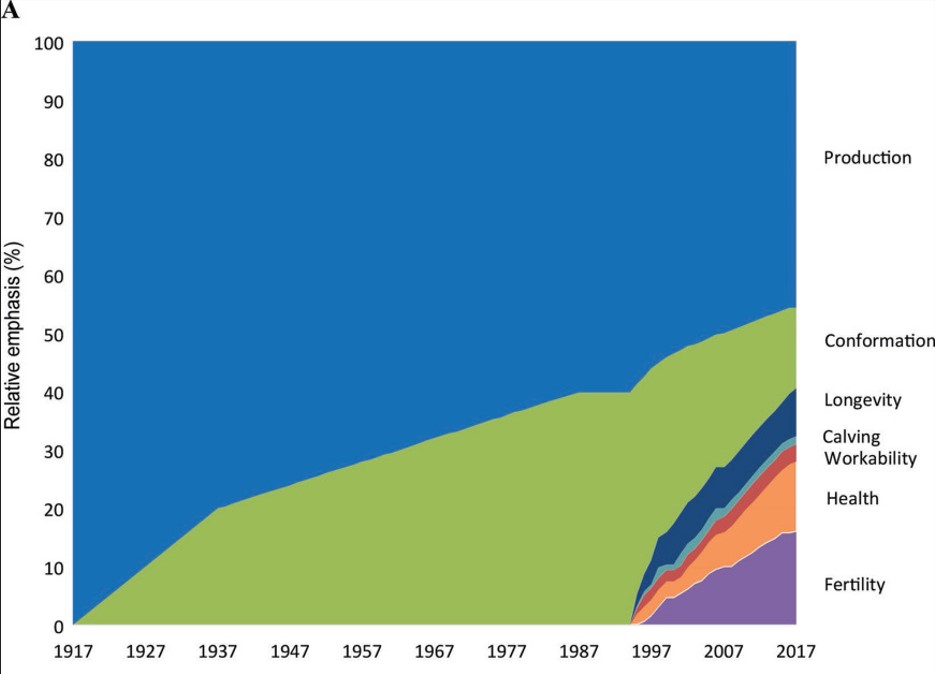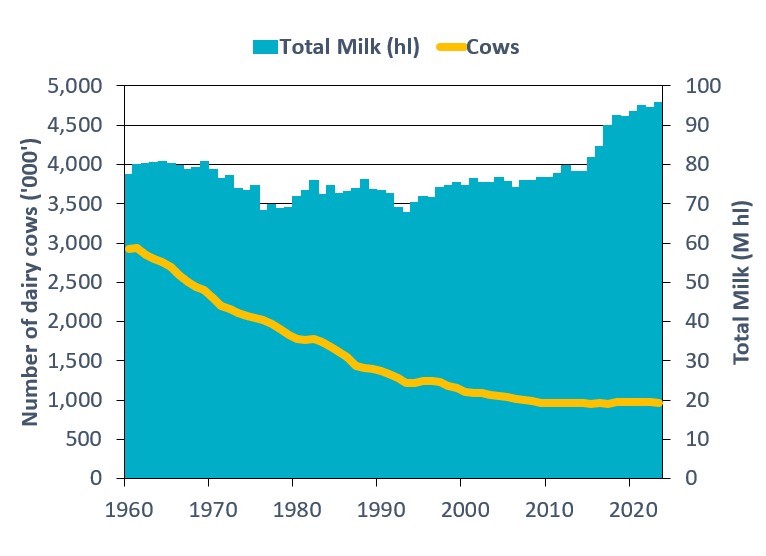Dr. Christine Baes deliveres the 2025 Dr. H Allen and Ann Tucker lecture
University of Guelph professor discussed opportunities and challenges in sustainable dairy genomics.

During the first week of October, the Michigan State University Animal Science Department had the privilege of hosting Dr. Christine Baes as the 2025 Dr. H. Allen and Ann Tucker Lecturer. Dr. Christine Baes is a Professor and Canada Research Chair in Livestock Genomics at the University of Guelph. She is also currently serving as the Acting Associate Dean of External Relations at Guelph. Dr. Baes’ talk, “Challenges and Opportunities in Sustainable Dairy Genomics,” explored where dairy genomics started, current challenges and the exciting new opportunities the industry has moving forward.
Overview of dairy genomics
At its core, genetics can be summed up in the simple equation Phenotype = Genotype + Environment. Development for production goals over the past 100 years for genomics has largely focused on production and confirmation-based traits including mammary system, feet and legs, dairy strength and rump. However, in recent years, there has been a shift toward selecting traits such as longevity, calving ease, workability, health and fertility. Dr. Baes emphasized the increased genetic gains observed since the adoption of genomic selection are largely due to the improved reliability of genomic evaluations compared to traditional parent averages, with improvements ranging from 31% to 41%. Despite these advances, multifactorial traits with low heritability—such as fertility, health and environmental efficiency—remain challenging. These traits are not only difficult to measure but are also heavily influenced by environmental conditions, making genetic progress slower. Nevertheless, improving these multifactorial traits is essential for advancing the dairy industry.

Challenges in reproductive traits
To improve fertility trait phenotypes, more detailed and biologically relevant data collection is needed to ensure fair comparisons. Dr. Baes presented several examples, including heifer age at first service, heifer first service to conception, calving to first service and first service to conception in cows. Over the past decade, metrics such as days open, calving to first service, and calving interval have each decreased by about ten days. While this progress is encouraging, further improvements are possible.
Dr. Baes highlighted the importance of increasing the quantity and quality of information and posed the question: what more can be done to improve these outcomes? Numerous factors, including nutrition, stress and pathogens influence fertility traits. Management practices such as timed artificial insemination (TAI) may artificially enhance the reproductive performance of less fertile cows, potentially masking “natural” reproductive performance. If TAI protocols are not properly recorded and differentiated from natural heat detection, nearly half of the potential genetic gain could be lost over 20 generations. Without accurate documentation of management decisions, it becomes difficult to distinguish naturally fertile cows from those that are not. These challenges present an opportunity to develop novel phenotypes that are less affected by management practices.
“Novel” fertility traits
Baes introduced several “novel” fertility traits that could serve as genetic tools. One such trait is size and position scoring of the uterine tract. Preliminary data suggest that animals with smaller, higher-positioned tracts have a higher pregnancy rate per insemination. Although initial heritability estimates are around 10%, this trait could be easily measured by producers, potentially increasing its reliability and usefulness in selection programs. Another promising trait is anogenital distance (AGD), the distance between the anus and the clitoris. A shorter AGD is positively correlated with reproductive success, including higher pregnancy rates, improved follicular recruitment and other favorable outcomes.

Finally, standardizing phenotypes using automated sensors offers additional opportunities to examine physiological factors affecting estrous expression and embryo survival. Sensor data could help identify genomic markers linked to estrus and fertility. Examples include days between calving and first estrus and the maximum intensity of estrous behavior, both of which reflect biological processes rather than management interventions.
Health traits
In terms of health traits, Dr. Baes discussed the use of genomic indices to evaluate fertility disorders. Canada added indexes for metritis, retained placenta, and cystic ovaries in 2020. Although heritability for these traits is low (2–3%), Dr. Baes highlighted that when looking at the top and bottom 10% population extremes of sire offspring, there is a difference in offspring performance. For example, the percentage of healthy lactations was 95% for top sires compared to 77% for bottom sires. Baes also shared research on calf health using DairyComp data from 1,890 Canadian dairy herds. Her team found genetic components for diarrhea and respiratory issues in calves. By modeling disease transmission, they explored genetic selection for both susceptibility and infectivity. However, Dr. Baes emphasized that genetics alone cannot overcome poor environmental conditions. Traits such as mastitis resistance, metabolic disease resistance, hoof health, fertility disorders and calf health can be incorporated into breeding programs, but their success depends on accurate and consistent data recording.
Environmental sustainability traits
Environmental sustainability is another critical area of focus. Although there is now increased milk production with fewer cows, the industry still faces scrutiny over its environmental impact, particularly methane emissions. The Resilient Dairy Genome Project (RDGP) is an international research initiative aimed at developing genomic tools to breed more resilient dairy cows. Improving feed efficiency and reducing greenhouse gas emissions are the top priorities of this project.

Dr. Baes shared Canada’s contributions to the RDGP, including the development of a genetic evaluation system for feed efficiency and methane emissions. Methane Efficiency (ME) evaluations are based on predicted methane output rather than individual measurements, allowing for genetic selection of low-methane-emitting cows. Researchers tested this single-nucleotide polymorphism (SNP) across cows from multiple countries and observed differences in methane production among various efficiency groups. While further research is needed, these findings represent an exciting step toward reducing the environmental footprint of dairy production through genomic innovation.
Learn more about Dr. H Allen Tucker and the Tucker Lecture series here. The recorded lecture is available online.



 Print
Print Email
Email


